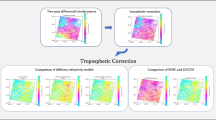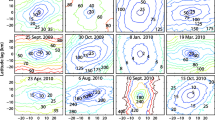Abstract
The Bodrum-Kos earthquake which occurred on 20th July 2017 at 1:31 am local time with a magnitude of Mw 6.6 in the Gulf of Gökova in Turkey. The Bodrum-Kos earthquake caused a small radius tsunami in Bodrum coast and its surroundings. Here, the Interferometric Synthetic Aperture Radar (InSAR) method was utilized to reveal tectonic deformation caused by the Bodrum-Kos earthquake. The InSAR technique was increasingly used to detect ground deformation such as landslide, tectonic or volcanic. In this study, the crucial atmospheric corrections which are GACOS and phase-elevation corrections on InSAR data are discussed. GACOS correction is based on high-resolution European Centre for Medium-Range Weather Forecasts weather model at 0.125° and 6-h resolutions, SRTM DEM and ASTER GDEM. GACOS is used to separate stratified and turbulent signals from tropospheric total delays and generate high spatial resolution zenith total delay maps to be used for correcting InSAR measurements and other applications. Phase-elevation linear correction is also used to separate mostly stratified signals from tropospheric total delays due to the topographic elevation changes and 3 arc second topographic map was used in the phase-elevation correction. These atmospheric correction methods were tried both separately and sequentially and standard deviations of each method were presented. The points comparison of the cumulative line of sight displacement maps were made after and before correction. The point on the Karaada (C point) shows subsidence after the earthquake and then recovers again. Time-series results of all points show similar values until the earthquake occurs. Time-series result also shows that the Bodrum-Kos earthquake has a small radius effect over the land area only the north and maybe west island due to the occurrence on the sea and lost its much energy without reaching the land.



















Similar content being viewed by others
Change history
18 November 2020
Unfortunately the following reference has been omitted.
References
Albino, F., Biggs, J., & Syahbana, D. K. (2019). Dyke intrusion between neighbouring arc volcanoes responsible for 2017 pre-eruptive seismic swarm at Agung. Nature Communications, 10(1), 748.
Albino, F., Biggs, J., Yu, C., & Li, Z. (2020). Automated methods for detecting volcanic deformation using Sentinel-1InSAR time series illustrated by the 2017–2018 unrest at Agung, Indonesia. Journal of Geophysical Research: Solid Earth. https://doi.org/10.1029/2019JB017908.
Biggs, J., Bergman, E., Emmerson, B., Funning, G. J., Jackson, J., Parsons, B., & Wright, T. J. (2006). Fault identification for buried strike-slip earthquakes using InSAR: The 1994 and 2004 Al Hoceima, Morocco earthquakes. Geophysical Journal International, 166(3), 1347–1362.
Biggs, J., Burgmann, R., Freymueller, J. T., Lu, Z., Parsons, B., Ryder, I., & Wright, T. (2009). The postseismic response to the 2002 M 7.9 Denali Fault earthquake: Constraints from InSAR 2003–2005. Geophysical Journal International, 176(2), 353–367.
Biggs, J., Robinson, D. P., & Dixon, T. H. (2009). The 2007 Pisco, Peru, earthquake (M 8.0): Seismology and geodesy. Geophysical Journal International, 176(3), 657–669.
Bos, A. G., Usai, S., & Spakman, W. (2004). A joint analysis of GPS motions and InSAR to infer the coseismic surface deformation of the Izmit, Turkey earthquake. Geophysical Journal International, 158(3), 849–863.
Burgmann, R., Ayhan, M. E., Fielding, E. J., Wright, T. J., McClusky, S., Aktug, B., & Turkezer, A. (2002). Deformation during the 12 November 1999 Duzce, Turkey, earthquake, from GPS and InSAR data. Bulletin of the Seismological Society of America, 92(1), 161–171.
Chlieh, M., De Chabalier, J. B., Ruegg, J. C., Armijo, R., Dmowska, R., Campos, J., & Feigl, K. L. (2004). Crustal deformation and fault slip during the seismic cycle in the North Chile subduction zone, from GPS and InSAR observations. Geophysical Journal International, 158(2), 695–711.
Cordrie, L., Gailler, A., Heinrich, P., Hébert, H., & Schindelé, F. (2018). Tsunami modeling of the 20th July 2017 Mw 6.6 earthquake in the Aegean Sea. In EGU General Assembly Conference Abstracts, 20, 15114.
Delouis, B., Lundgren, P., Salichon, J., & Giardini, D. (2000). Joint inversion of InSAR and teleseismic data for the slip history of the 1999 Izmit (Turkey) earthquake. Geophysical Research Letters, 27(20), 3389–3392.
Dewey, J. F. (1988). Extensional collapse of orogens. Tectonics, 7(6), 1123–1139.
Dewey, J. F., & Şengör, A. M. C. (1979). Aegean and surrounding regions: complex multi-plate and continuum tectonics in a convergent zone. Geological Society of America Bulletin, 90(1), 89–92.
Dogan, U., Demir, D. Ö., Çakir, Z., Ergintav, S., Ozener, H., Akoğlu, A. M., & Reilinger, R. (2014). Postseismic deformation following the Mw 7.2, 23 October 2011 Van earthquake (Turkey): Evidence for aseismic fault reactivation. Geophysical Research Letters, 41(7), 2334–2341.
Doin, M. P., Lasserre, C., Peltzer, G., Cavalié, O., & Doubre, C. (2009). Corrections of stratified tropospheric delays in SAR interferometry: Validation with global atmospheric models. Journal of Applied Geophysics, 69(1), 35–50.
Elliott, J. R., Copley, A. C., Holley, R., Scharer, K., & Parsons, B. (2013). The 2011 Mw 7.1 Van (eastern Turkey) earthquake. Journal of Geophysical Research Solid Earth, 118(4), 1619–1637.
Ergintav, S., McClusky, S., Hearn, E., Reilinger, R., Cakmak, R., Herring, T., & Tari, E. (2009). Seven years of postseismic deformation following the 1999, M= 7.4 and M= 7.2, Izmit-Düzce, Turkey earthquake sequence. Journal of Geophysical Research Solid Earth, 114(B7), 1–19.
Feng, W., Li, Z., Hoey, T., Zhang, Y., Wang, R., Samsonov, S., & Xu, Z. (2014). Patterns and mechanisms of coseismic and postseismic slips of the 2011 MW 7.1 Van (Turkey) earthquake revealed by multi-platform synthetic aperture radar interferometry. Tectonophysics, 632, 188–198.
Fielding, E. J., Lundgren, P. R., Taymaz, T., Yolsal-Çevikbilen, S., & Owen, S. E. (2013). Fault-slip source models for the 2011 M 7.1 Van earthquake in Turkey from SAR interferometry, pixel offset tracking, GPS, and seismic waveform analysis. Seismological Research Letters, 84(4), 579–593.
Ganas, A., Elias, P., Kapetanidis, V., Valkaniotis, S., Briole, P., Kassaras, I., & Moshou, A. (2018). The July 20, 2017 M6. 6 Kos-Bodrum earthquake: seismic and geodetic evidence for a north-dipping, normal fault at the western end of the Gulf of Gökova, SE Aegean Sea. In EGU General Assembly Conference Abstracts, 20, 9262.
González, P. J., Walters, R. J., Hatton, E. L., Spaans, K., McDougall, A., Hooper, A. J., & Wright, T. J. (2016). LiCSAR: Tools for automated generation of Sentinel-1 frame interferograms. Ion AGU Fall Meeting.
Hamiel, Y., & Fialko, Y. (2007). Structure and mechanical properties of faults in the North Anatolian Fault system from InSAR observations of coseismic deformation due to the 1999 Izmit (Turkey) earthquake. Journal of Geophysical Research Solid Earth, 112(B7), 1–12.
Hanssen, R. F. (2001). Radar interferometry: Data interpretation and error analysis. Dordrecht: Kluwer Academic Publishers.
Hooper, A., Wright, T. J., Spaans, K., Elliott, J., Weiss, J. R., Bagnardi, M., & McDougall, A. (2018). Global monitoring of fault zones and volcanoes with Sentinel-1. In IGARSS 2018–2018 IEEE International Geoscience and Remote Sensing Symposium (pp. 1566–1568).
Jolivet, R., Grandin, R., Lasserre, C., Doin, M. P., & Peltzer, G. (2011). Systematic InSAR tropospheric phase delay corrections from global meteorological reanalysis data. Geophysical Research Letters, 38(17), 1–6.
Kaneko, Y., Fialko, Y., Sandwell, D. T., Tong, X., & Furuya, M. (2013). Interseismic deformation and creep along the central section of the North Anatolian fault (Turkey): InSAR observations and implications for rate-and-state friction properties. Journal of Geophysical Research Solid Earth, 118(1), 316–331.
Karasözen, E., Nissen, E., Büyükakpınar, P., Cambaz, M. D., Kahraman, M., Kalkan, E., & Özacar, A. A. (2018). The 2017 July 20 M w 6.6 Bodrum-Kos earthquake illuminates active faulting in the Gulf of Gökova, SW Turkey. Geophysical Journal International, 214(1), 185–199.
Konca, A. O., Guvercin, S. E., Ozarpaci, S., Ozdemir, A., Funning, G. J., Dogan, U., & Reilinger, R. (2019). Slip distribution of the 2017 M w6. 6 Bodrum-Kos earthquake: resolving the ambiguity of fault geometry. Geophysical Journal International, 219(2), 911–923.
Lawrence, B. N., Bennett, V. L., Churchill, J., Juckes, M., Kershaw, P., Pascoe, S., et al. (2013). Storing and manipulating environmental big data with JASMIN. San Francisco: IEEE Big Data.
Le Mouélic, S., Raucoules, D., Carnec, C., & King, C. (2005). A least squares adjustment of multi-temporal InSAR data. Photogrammetric Engineering and Remote Sensing, 71(2), 197–204.
Le Pichon, X., & Angelier, J. (1979). The Hellenic arc and trench system: A key to the evolution of eastern Mediterranean area. Tectonophysics, 60, 1–42.
Michel, R., & Avouac, J. P. (2002). Deformation due to the 17 August 1999 Izmit, Turkey, earthquake measured from SPOT images. Journal of Geophysical Research Solid Earth, 107(B4), 1–8.
Morishita, Y., Lazecky, M., Wright, T. J., Weiss, J. R., Elliott, J. R., & Hooper, A. (2020). LiCSBAS: An open-source InSAR time series analysis package integrated with the LiCSAR automated Sentinel-1 InSAR processor. Remote Sensing, 12, 424.
Motagh, M., Schurr, B., Anderssohn, J., Cailleau, B., Walter, T. R., Wang, R., & Villotte, J. P. (2010). Subduction earthquake deformation associated with 14 November 2007, Mw 7.8 Tocopilla earthquake in Chile: Results from InSAR and aftershocks. Tectonophysics, 490(1–2), 60–68.
Reilinger, R. E., Ergintav, S., Burgmann, R., McClusky, S., Lenk, O., Barka, A., & Aktug, B. (2000). Coseismic and postseismic fault slip for the 17 August 1999, M= 7.5, Izmit, Turkey earthquake. Science, 289(5484), 1519–1524.
Sengör, A. M. C., Satir, M., & Akkök, R. (1984). Timing of tectonic events in the Menderes Massif, western Turkey: Implications for tectonic evolution and evidence for Pan-African basement in Turkey. Tectonics, 3(7), 693–707.
Seyitoğlu, G., & Scott, B. C. (1991). Late Cenozoic crustal extension and basin formation in west Turkey. Geological Magazine, 128, 155–221.
Simons, M., Fialko, Y., & Rivera, L. (2002). Coseismic deformation from the 1999 M w 7.1 Hector Mine, California, earthquake as inferred from InSAR and GPS observations. Bulletin of the Seismological Society of America, 92(4), 1390–1402.
Tiryakioğlu, İ, Aktuğ, B., Yiğit, C. Ö., Yavaşoğlu, H. H., Sözbilir, H., Özkaymak, Ç., & Özener, H. (2018). Slip distribution and source parameters of the 20 July 2017 Bodrum-Kos earthquake (Mw6. 6) from GPS observations. Geodinamica Acta, 30(1), 1–14.
Usai, S. (2003). A least squares database approach for SAR interferometric data. IEEE Transactions on Geoscience and Remote Sensing, 41(4), 753–760.
Wang, C., Ding, X., Li, Q., Shan, X., Zhu, W., Guo, B., & Liu, P. (2015). Coseismic and postseismic slip models of the 2011 Van earthquake, Turkey, from InSAR, offset-tracking, MAI, and GPS observations. Journal of Geodynamics, 91, 39–50.
Werner, C., Wegmüller, U., Strozzi, T., & Wiesmann, A. (2000). Gamma SAR and interferometric processing software. In Proceedings of the ERS-ENVISAT symposium, Gothenburg, Sweden, 1620.
Wright, T., Fielding, E., & Parsons, B. (2001). Triggered slip: Observations of the 17 August 1999 Izmit (Turkey) earthquake using radar interferometry. Geophysical Research Letters, 28(6), 1079–1082.
Wright, T. J., Parsons, B. E., & Lu, Z. (2004). Toward mapping surface deformation in three dimensions using InSAR. Geophysical Research Letters, 31(1), 1–5.
Yu, C., Penna, N. T., & Li, Z. (2017). Generation of real-time mode high-resolution water vapor fields from GPS observations. Journal of Geophysical Research Atmospheres, 122(3), 2008–2025.
Yu, C., Li, Z., Penna, N. T., & Crippa, P. (2018). Generic atmospheric correction model for Interferometric Synthetic Aperture Radar observations. Journal of Geophysical Research Solid Earth, 123(10), 9202–9222.
Yu, C., Li, Z., & Penna, N. T. (2018). Interferometric synthetic aperture radar atmospheric correction using a GPS-based iterative tropospheric decomposition model. Remote Sensing of Environment, 204, 109–121.
Acknowledgements
I would like to thank Dr. Fabien Albino and Prof. Dr. Juliet Biggs for their kindly assistance with atmospheric corrections. Besides, I would like to thank the reviewers and the editor for their helpful comments on the paper. Also, I would like to thank COMET-LiCS Sentinel-1 Sentinel Portal which contains modified Copernicus Sentinel data [2017] analysed by the Centre for the Observation and Modelling of Earthquakes, Volcanoes and Tectonics (COMET). LiCSAR uses JASMIN, the UK’s collaborative data analysis environment (https://jasmin.ac.uk).
Author information
Authors and Affiliations
Corresponding author
Additional information
Publisher's Note
Springer Nature remains neutral with regard to jurisdictional claims in published maps and institutional affiliations.
The original version of this article was revised: reference Albino et al. 2020 has been omitted.
Rights and permissions
About this article
Cite this article
Dogru, F. The Importance of Atmospheric Corrections on InSAR Surveys Over Turkey: Case Study of Tectonic Deformation of Bodrum-Kos Earthquake. Pure Appl. Geophys. 177, 5761–5780 (2020). https://doi.org/10.1007/s00024-020-02606-w
Received:
Revised:
Accepted:
Published:
Issue Date:
DOI: https://doi.org/10.1007/s00024-020-02606-w




